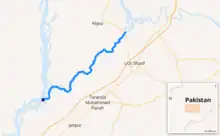Panjnad River
The Panjnad River (Punjabi and Urdu: پنجند) is a river at the extreme end of the Bahawalpur district in the Punjab province of Pakistan. The name Panjnad is derived from Sanskrit words pancha ("five") and nadī́ ("river") which means "five rivers". The Panjnad River is formed by the successive confluence or merger of the five rivers of Punjab: the Jhelum River, the Chenab River, the Ravi River, the Beas River and the Sutlej River.[1][2][3][4]
| Panjnad River | |
|---|---|
 | |
| Native name | پنجند (Punjabi) |
| Physical characteristics | |
| Mouth | Indus River |
• location | Mithankot |
• coordinates | 28°56′59.99″N 70°29′59.99″E |
| Length | 71 km (44 mi) |
| Basin size | 395,000 km2 (153,000 sq mi) |
| Discharge | |
| • location | Mithankot (near mouth) |
| • average | 2,500 m3/s (88,000 cu ft/s) |
| Basin features | |
| Tributaries | |
| • left | Chenab |
| • right | Sutlej |
The Jhelum and the Ravi rivers join the Chenab River; the Beas River joins the Sutlej River; and the Sutlej and the Chenab rivers join to form the Panjnad River. It is 10 miles north of Uch Sharif in the Muzaffar Garh district. The combined stream runs southwest for approximately 44 miles and joins the Indus River at Mithankot. The Indus River continues and then drains into the Arabian Sea. A barrage on Panjnad has been erected which provides irrigation channels for Punjab and Sindh provinces south of the Sutlej River and east of the Indus River.[1]

Beyond the confluence of the Indus and Panjnad rivers, the Indus River was known as Satnad (Sat = seven) carrying the waters of seven rivers including the Indus River, the five Punjab rivers, and the Kabul River.
References
- Panjnad River on Encyclopædia Britannica website Retrieved 16 January 2021
- Topography and Drainage of Pakistan on countrystudies.us website Retrieved 16 January 2021
- Panjnad River with major tributaries of Indus River
- "Trimmu and Panjnad Barrages Improvement Project: Rehabilitation and Upgrading of Panjnad Barrage - Asian Development Bank Project Document Page No. 25".